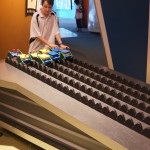Saratoga Polo. Fabulous, as usual.
Mystic trip (Part V)
On the way home, we stopped at the Connecticut Science Center in Hartford. The kids loved it. Well worth a stop.
Mystic, CT trip (Part IV)
Mystic itself was nice. A walkable community on the water.
Mystic, CT trip (Part III)
The U.S. Submarine Force Library and Museum in nearby Groton, CT, was worth checking out.
Mystic, CT trip (Part II)
We checked out Mystic Seaport, a “living history museum.” Enjoyable for kids and adults.
Mystic, CT trip (Part I)
So we decided to take advantage of the long July 4th weekend and take a road trip to Mystic, Ct. On the way there, we stopped at the Yale University Art Museum in New Haven.
Highly recommended. Very family-friendly.
Detroit: An American Autopsy
 Even though I am genuinely interested in understanding what happened in Detroit and why, there a certain level of guilt involved in reading a book like Charlie LeDuff’s Detroit: An American Autopsy.
Even though I am genuinely interested in understanding what happened in Detroit and why, there a certain level of guilt involved in reading a book like Charlie LeDuff’s Detroit: An American Autopsy.
Don’t get me wrong — it’s a great read. The guy knows how to tell a story. But it left me with the sad feeling like there is not a lot of good news to be had in places like Detroit, and that I shouldn’t have been so interested in all of that badness. He tells it like it is, and shares his family’s stories as well. Some of which are pretty heart-wrenching.
Read reviews from the New York Times and Goodreads.
Racing the Beam
 I’d never heard of “platform studies” before, but in “Racing the Beam” (2009) Nick Montfort and Ian Bogost do a good job of telling the history of the Atari 2600 gaming console from the perspective of its game developers. The book got a bit technical at times, but it was not overwhleming for the non-techie. And now I understand why the 2600 games that were ported from arcade versions looked almost nothing like the originals.
I’d never heard of “platform studies” before, but in “Racing the Beam” (2009) Nick Montfort and Ian Bogost do a good job of telling the history of the Atari 2600 gaming console from the perspective of its game developers. The book got a bit technical at times, but it was not overwhleming for the non-techie. And now I understand why the 2600 games that were ported from arcade versions looked almost nothing like the originals.
A good read for anyone who spent as much time as I did playing the Atari back in the day.
Read more from the publisher, and reviews from Wired and Retro Thing.
The Age of Edison

A very interesting and enlightening read.
Read reviews from the Washington Post and the Wall Street Journal.















































